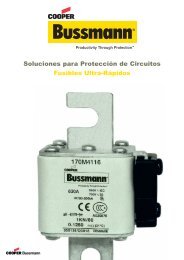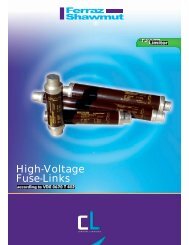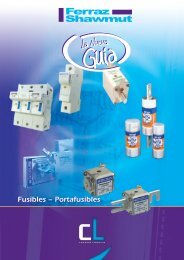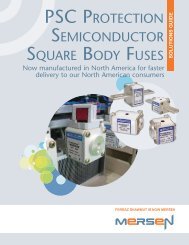Bussmann
Create successful ePaper yourself
Turn your PDF publications into a flip-book with our unique Google optimized e-Paper software.
Fuse Technology<br />
<strong>Bussmann</strong> ®<br />
<strong>Bussmann</strong> Dual-Element Fuses<br />
®<br />
There are many advantages to using these fuses. Unlike single-element fuses, the <strong>Bussmann</strong> ® dual-element, time-delay fuses can be sized closer to provide both high performance shortcircuit<br />
protection and reliable overload protection in circuits subject to temporary overloads and surge currents. For ac motor loads, a single-element fuse may need to be sized at 300% of an<br />
a.c. motor current in order to hold the starting current. However, dual-element, time delay fuses can be sized much closer to motor loads. For instance, it is generally possible to size FUSETRON ®<br />
Dual-Element Fuses, FRS-R and FRN-R and LOW-PEAK ® Dual-Element Fuses, LPS-RK_SP and LPN-RK_SP, at 125% and 130% of motor full load current, respectively. Generally, the LOW-<br />
PEAK ® Dual-Element Fuses, LPJ_SP, and CUBEFuse TM , TCF, can be sized at 150% of motor full load amperes. This closer fuse sizing may provide many advantages such as: (1)<br />
smaller fuse and block, holder or disconnect ampere rating and physical size, (2) lower cost due to lower ampere rated devices and possibly smaller required panel space, (3) better<br />
short-circuit protection – less short-circuit current let-through energy, and (4) potential reduction in the arc flash hazard.<br />
Insulated end-caps to help prevent<br />
accidental contact with live parts.<br />
Filler material<br />
Figure 6. This is the LPS-RK100SP, a 100A, 600V LOW-PEAK ® , Class RK1, Dual-Element Fuse that has excellent time-delay, excellent current-limitation and a 300,000A interrupting rating.<br />
Artistic liberty is taken to illustrate the internal portion of this fuse. The real fuse has a non-transparent tube and special small granular, arc-quenching material completely filling the<br />
internal space.<br />
Small volume of metal to vaporize<br />
Short-circuit element<br />
Overload element<br />
Figure 7. The true dual-element fuse has distinct and separate overload<br />
element and short-circuit element.<br />
Figure 9. Short-circuit operation: Modern fuses are designed with minimum metal in the<br />
restricted portions which greatly enhance their ability to have excellent current-limiting<br />
characteristics – minimizing the short circuit let-through current. A short-circuit<br />
current causes the restricted portions of the short-circuit element to vaporize and arcing<br />
commences. The arcs burn back the element at the points of the arcing. Longer arcs result,<br />
which assist in reducing the current. Also, the special arc quenching filler material contributes<br />
to extinguishing the arcing current. Modern fuses have many restricted portions,<br />
swhich results in many small arclets – all working together to force the current to zero.<br />
Before<br />
Filler quenches the arcs<br />
Spring<br />
After<br />
Figure 8. Overload operation: Under sustained overload conditions, the trigger spring<br />
fractures the calibrated fusing alloy and releases the “connector”. The insets represent a<br />
model of the overload element before and after. The calibrated fusing alloy connecting the<br />
short-circuit element to the overload element fractures at a specific temperature due to a<br />
persistant overload current. The coiled spring pushes the connector from the short-circuit<br />
element and the circuit is interrupted.<br />
Figure 10. Short-circuit operation: The special small granular, arc-quenching material<br />
plays an important part in the interruption process. The filler assists in quenching the arcs;<br />
the filler material absorbs the thermal energy of the arcs, fuses together and creates an<br />
insulating barrier. This process helps in forcing the current to zero. Modern current-limiting<br />
fuses, under short-circuit conditions, can force the current to zero and complete the<br />
interruption within a few thousandths of a second.<br />
When the short-circuit current is in the current-limiting range of a fuse, it is not possible for the full available short-circuit current to flow through the fuse – it’s a matter of physics. The small<br />
restricted portions of the short-circuit element quickly vaporize and the filler material assists in forcing the current to zero. The fuse is able to “limit” the short-circuit current.<br />
Overcurrent protection must be reliable and sure. Whether it is the first day of the electrical system or thirty or more years later, it is important that overcurrent protective devices perform under<br />
overload or short-circuit conditions as intended. Modern current-limiting fuses operate by very simple, reliable principles.<br />
213






